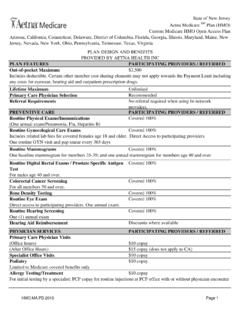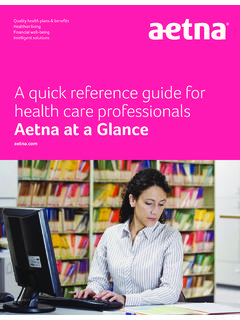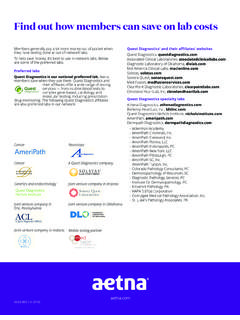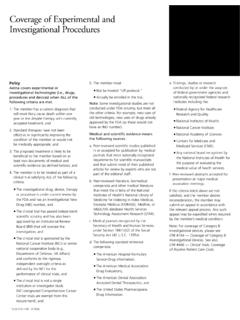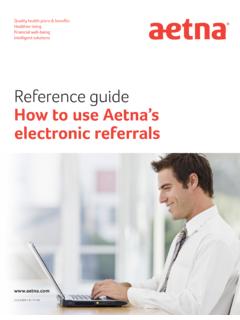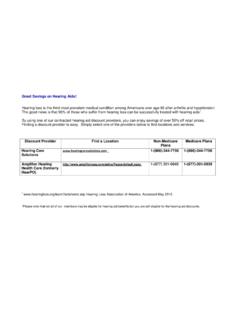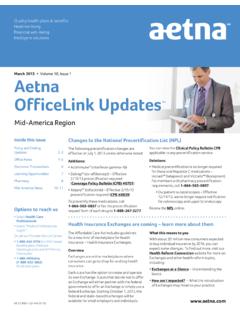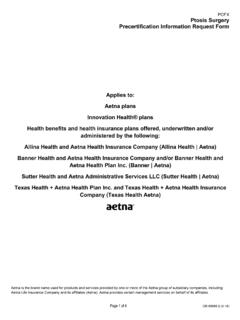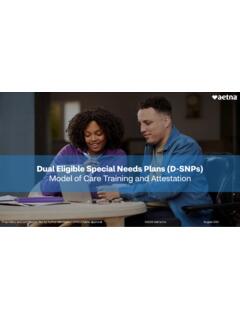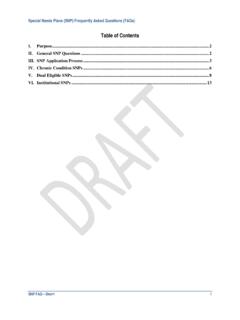Transcription of Dual Eligible Special Needs Plans (D-SNPs)
1 Dual Eligible Special Needs Plans (D- snps ) model of care training Proprietary and confidential;. not for further distribution without Aetna approval September 2018. Our mission Our Special Needs Plan (SNP) program was designed to optimize the health and well-being of our aging, vulnerable and chronically ill members. Our objectives Explain Dual Eligible Special Needs Plans (D- snps ). Describe what D- snps offer Describe which dually Eligible individuals qualify for these Plans Describe our model of care and care plan management programs Describe how Medicare and Medicaid benefits are coordinated under the Plans Expand on the enhanced benefits of D- snps Explain how to get answers to your questions 2018 Aetna Inc. 3. CMS requirements The Centers for Medicare & Medicaid Services (CMS) requires all contracted medical providers and staff receive basic training about the Special Needs Plans ( snps ) model of care .
2 The snps model of care is the plan for delivering coordinated care and care management to Special Needs members. This course will describe how Aetna, Coventry and their contracted providers can work together to successfully deliver the snps model of care . 2018 Aetna Inc. 4. Background 2003 2008 2011. snps were created as part CMS contracted with the The Patient Protection of the Medicare National Committee for and Affordable care Act Modernization Act. Quality Assurance (NCQA) to (ACA) mandated further develop a strategy to snps program changes: evaluate the quality of care provided by snps . Requires all snps to submit Models of care (MOCs) that comply with an approval process based on CMS standards NCQA must review and approve these MOCs 2018 Aetna Inc.
3 5. Special Needs Plans features Medicare snps feature: Enrollment limited to beneficiaries within the target SNP population Benefit Plans are custom designed to meet the Needs of the target population Additional election periods throughout the year during which members may change their coverage Three types of snps designed for specific groups of members with Special health care Needs . 1. Individuals dually Eligible for Medicare and Medicaid (D-SNP). 2. Individuals with chronic conditions (C-SNP). 3. Individuals who are institutionalized or Eligible for nursing home care (I-SNP). 2018 Aetna Inc. 6. D- snps are custom designed to have the following structures The D- snps program is available to Eligible members: Residing within the program's service area Meeting dual eligibility status requirements In many states, we'll enroll partial benefit duals as well as full benefit duals Dual eligibility qualification is determined by the member's enrollment in: A federally administered Medicare program based on age and/or disability status The state-administered Medicaid program based on low income and assets 2018 Aetna Inc.
4 7. Who are dual eligibles? Primary coverage for dual eligibles: Medicare is always primary Medicaid is the payer of last resort and supplements Medicare coverage How do people become dual Eligible ? Medicare Dual Medicaid Qualify on the basis of assets and income through the Eligible Medicare Savings Program (MSP). Eligibility for SSI. Other optional means such as medically needy or through Section 1115 waiver; state specific Receives full Medicaid Duals may be full benefit duals or partial benefit duals . Enrolled in benefits and/or Medicare assistance with Medicare Full duals are Eligible for Medicaid benefits Part A and/or premiums or cost Part B sharing via one of the Partial duals are only Eligible for premium and for some four Medicare Savings levels, assistance with Medicare cost share Program (MSP).
5 Categories States set asset levels that determine full benefit status 2018 Aetna Inc. 8. model of care goals Each Special Needs Plan program must develop a model of care (MOC) and a Quality Improvement Plan to evaluate its effectiveness. The MOC is a plan for delivering care management and care coordination to: 1. Improve quality 2. Increase access 3. Create affordability 4. Integrate and coordinate care across specialties 5. Provide seamless transitions of care 6. Improve use of preventive health services 7. Encourage appropriate utilization and cost effectiveness 8. Improve member health 9. The model of care design includes the following Health risk assessment tool (HRAT)*. Interdisciplinary care team (ICT). care management team Individualized care plan (ICP).
6 care coordination D-DSNP benefits Provider role Staff role *HRA completion is a STARS measure 2018 Aetna Inc. 10. Health risk assessment The health risk assessments (HRAs): Help identify members with the most urgent Needs Are an important part of the member's care coordination Contain member self-reported information Help create the members Individualized care plan Assess the following Needs of each member: Medical Functional Cognitive Psychosocial Mental health Are completed telephonically by the care management team: Within 90 days of enrollment Repeated within 365 days 2018 Aetna Inc. 11. Interdisciplinary care team (ICT). The interdisciplinary care team (ICT): Each member is managed by a care team SNP. management team Participants are based on the member's Needs Primary Home care health care managers will keep the team updated provider with information involving the member's care plan Member Team meets formally Vendors & care Specialists manager Smaller meetings occur, as needed Family/.
7 Pharmacists caregiver Social services 2018 Aetna Inc. 12. Interdisciplinary care team's (ICT) role Determine each member's goals and Needs Coordinate member care Identify problems and anticipate crises Educate members about their conditions and medications Coach members to use their individualized care plan Refer members to community resources Manage transitions Identify problems that could cause transitions Try to prevent unplanned transitions Coordinate Medicare and Medicaid benefits for members Identify and assist members with changes in their Medicaid eligibility 2018 Aetna Inc. 13. Individualized care plan (ICP). An ICP is the mechanism for evaluating the member's current health status. It is the ongoing action plan to address the member's care Needs in conjunction with the ICT and member.
8 These Plans contain member-specific problems, goals and interventions, addressing issues found during the HRA and any team interactions. An ICP is developed and maintained for each D-SNP member using: Health risk assessment results Laboratory results, pharmacy, emergency department and hospital claims data care manager interaction Interdisciplinary care team input Member preferences and personal goals This is a living document that changes as the member changes. 2018 Aetna Inc. ICP continued . D-SNP members are tiered Using the information obtained by the HRA and ICT, D-SNP members are tiered and placed into various 3. clinical programs to improve their health and well-being. High tier 3 are the most vulnerable members, includes those with high 2.
9 Utilization and multiple unmanaged chronic conditions that put them at risk for unplanned transitions of care . Medium tier 2 members generally have multiple chronic conditions, some of which 1. may not be managed. Low tier 1 contains the most stable SNP members. 2018 Aetna Inc. 15. ICP continued . Member profile Summarizes the individualized care plan (ICP). Captures HEDIS gaps in care Contains medication review notes from health plan pharmacists Includes diagnoses from claims data, certain lab results and a list of current medications filled by member The HRA, ICP and member profile for each member are available to the PCP at all times through our secure member/provider portal 2018 Aetna Inc. 16. care coordination Integrate and coordinate care across specialties The health plan integrates and coordinates care for D-SNP members across the care continuum through a central point of contact.
10 The care manager (CM) functions as this central contact across all settings and providers. To improve coordination of care : The PCP is the gatekeeper and responsible for identifying the Needs of the beneficiary. The CM coordinates care with the member, the member's PCP and other participants of the member's ICT. All SNP members have a PCP and a CM. Through seamless transitions between care settings by: Notifying the member's PCP of the transition Sharing the member's ICP with the PCP, the hospitalist, the facility, and/or the member/caregiver (where applicable). Contacting the member prior to a planned transition to provide educational materials and answer questions related to the upcoming transition 2018 Aetna Inc. 17. care coordination continued.
